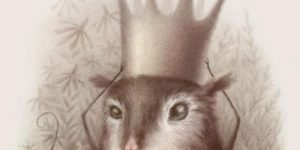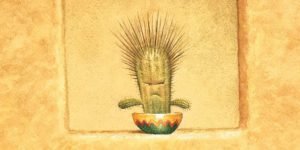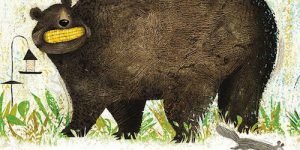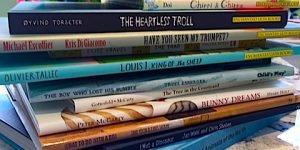For the past few years, I’ve updated my list of favourite CHRISTMAS picture books, which itself is built upon a comprehensive list of all the books in my collection that are in some way related to Christmas (49 and counting.) In my house, Christmas encompasses a very  broad range of experiences, from sprinkles to snow, family, friends, all the Who’s down in Whoville, chocolate gingerbread, fancy exterior lighting, Boney M, and of course, books. Some years are lean, illustratively speaking, while others offer a jolly good selection of festively inclined picture books, as is the case this year. And so, I am pleased to add seven new titles to the list, though only three were published in 2013. The neverending search for outstanding picture books, Christmas or otherwise, is an exercise in time travel. Some books hide in the past, others hide in plain sight. The only criteria: they must knock my chestnuts off.
broad range of experiences, from sprinkles to snow, family, friends, all the Who’s down in Whoville, chocolate gingerbread, fancy exterior lighting, Boney M, and of course, books. Some years are lean, illustratively speaking, while others offer a jolly good selection of festively inclined picture books, as is the case this year. And so, I am pleased to add seven new titles to the list, though only three were published in 2013. The neverending search for outstanding picture books, Christmas or otherwise, is an exercise in time travel. Some books hide in the past, others hide in plain sight. The only criteria: they must knock my chestnuts off.
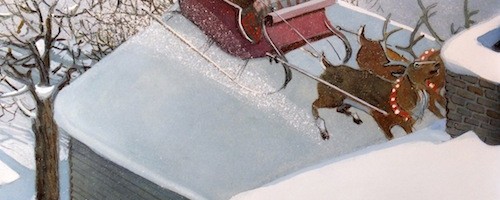
Christmas 2013
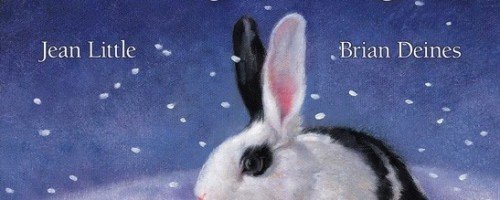
On a Snowy Night
I walk in the river valley and ravines of my city. It is my daily exercise, but more than that, it is my meditation. In the solitude and loveliness of nature, my cup runneth over. I’ve seen many miraculous things, but none that touched my heart more than an unlikely creature spotted one morning, nuzzling yellowed grass in the dead landscape of November. A small brown rabbit had taken up residence on a hill near the city’s centre. Large, sturdy-footed hares are ubiquitous in Edmonton, but this fellow was clearly domestic. Lost or abandoned, he had found a home beneath a set of stairs in full view of trail walkers like myself and the ever vigilant predatory wildlife who make their home in the river valley. I observed Brown Rabbit (pictured on the right) on numerous occasions, but after the first snow, I was surprised to find him 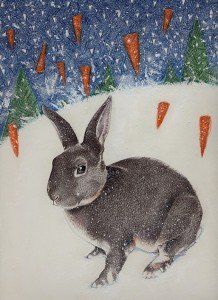 in his usual spot, nibbling a branch. After that, I began filling my pockets with vegetables and making strategic drops near the staircase. On good days, he would come out and feast on the bounty. Some days, usually cold days, he was nowhere to be found. I worried about Brown Rabbit, and I was not alone. Remnants of other ‘care packages’ were visible in the area, but calls to various wildlife rescue organizations proved fruitless. On the remote chance that he could be lured into a cage, no one was really interested in another abandoned domestic rabbit. “Best not to move him.” I was told.
in his usual spot, nibbling a branch. After that, I began filling my pockets with vegetables and making strategic drops near the staircase. On good days, he would come out and feast on the bounty. Some days, usually cold days, he was nowhere to be found. I worried about Brown Rabbit, and I was not alone. Remnants of other ‘care packages’ were visible in the area, but calls to various wildlife rescue organizations proved fruitless. On the remote chance that he could be lured into a cage, no one was really interested in another abandoned domestic rabbit. “Best not to move him.” I was told.
On a blue-sky December afternoon near Christmas, I sat on the steps in the park and watched Brown Rabbit emerge from beneath the stairs, nearer to me than he’d ever previously dared. Perched on the steps just above the rabbit, the sun fiercely bright and cold on my face, I listened as he nibbled on vegetable tops and straws of timothy hay. In that moment it felt like I’d entered a state of grace with this little life. On some level, Brown Rabbit understood that I meant no harm. An animal’s trust is a gift. Once earned, it must be safeguarded.
 On a Snowy Night by Jean Little, with illustrations by Brian Deines, is the story of a broken trust. It is also a story of compassion, and unexpected friendships. When a young boy named Brandon is given a rabbit for his fifth birthday, he names her Rosa and proclaims her ‘perfect.’ For awhile, the boy is attentive, but as is often the case with children and pets, interest wanes, and Brandon begins to neglect Rosa, even forgetting to feed her. Excited by the freshly fallen snow on Christmas Eve, Brandon brings Rosa outside and inadvertently leaves her there when he runs inside to answer a call. Rosa tries to find her way back, but gets lost. The chickadees warm Rosa with their down feathers and a squirrel finds Brandon’s lost mitten (apparently this kid is easily distracted), and gently nudges the still shivering rabbit onto its woolen surface. A raccoon pops the nose off a snowman and offers Rosa the carrot. “I thought wild animals ate each other?” says Rosa. “Not on this night,” replies a hawk, who leads the rabbit back to her home, where an anxious Brandon is reunited with his lost bunny. Interestingly, Jean Little ends the story ambiguously. While Rosa is happy to be back home, she is a realist (if rabbits can be realists.) On a snowy night, on Christmas Eve, kindness and friendship may be found in unlikely places.
On a Snowy Night by Jean Little, with illustrations by Brian Deines, is the story of a broken trust. It is also a story of compassion, and unexpected friendships. When a young boy named Brandon is given a rabbit for his fifth birthday, he names her Rosa and proclaims her ‘perfect.’ For awhile, the boy is attentive, but as is often the case with children and pets, interest wanes, and Brandon begins to neglect Rosa, even forgetting to feed her. Excited by the freshly fallen snow on Christmas Eve, Brandon brings Rosa outside and inadvertently leaves her there when he runs inside to answer a call. Rosa tries to find her way back, but gets lost. The chickadees warm Rosa with their down feathers and a squirrel finds Brandon’s lost mitten (apparently this kid is easily distracted), and gently nudges the still shivering rabbit onto its woolen surface. A raccoon pops the nose off a snowman and offers Rosa the carrot. “I thought wild animals ate each other?” says Rosa. “Not on this night,” replies a hawk, who leads the rabbit back to her home, where an anxious Brandon is reunited with his lost bunny. Interestingly, Jean Little ends the story ambiguously. While Rosa is happy to be back home, she is a realist (if rabbits can be realists.) On a snowy night, on Christmas Eve, kindness and friendship may be found in unlikely places.

Im Land Der Bücher ~ In the Land of Books
*Reading is the dream through foreign hands* Fernando Pessoa
 Im Land Der Bücher. In the Land of Books. As the title suggests, Im Land Der Bücher is a book about books; about the sometimes strange relationship we have with words, and the myriad states of being one assumes while lost in the pages of a good book. The illustrations in Im Land Der Bücher are not just extraordinarily evocative, they are also beautiful, and funny, and a little bit mournful; words that could describe virtually all paintings by Quint Buchholz, the German artist whose past subject matter includes elephants lumbering down the snowy streets of Canada, a quintet of musicians teetering on a rock, and a man playing a cello on a deserted field while a giant snail, his only audience, oozes by in the distance. In his newest book, Buchholz paints a woman in a bathtub, floating on the ocean. She is reading, and does not notice the beluga whale passing underneath. Where has this book taken her? Though not yet published in English (the author kindly provided a translation), Im Land Der Bücher is a fantastical journey worth taking in any language.
Im Land Der Bücher. In the Land of Books. As the title suggests, Im Land Der Bücher is a book about books; about the sometimes strange relationship we have with words, and the myriad states of being one assumes while lost in the pages of a good book. The illustrations in Im Land Der Bücher are not just extraordinarily evocative, they are also beautiful, and funny, and a little bit mournful; words that could describe virtually all paintings by Quint Buchholz, the German artist whose past subject matter includes elephants lumbering down the snowy streets of Canada, a quintet of musicians teetering on a rock, and a man playing a cello on a deserted field while a giant snail, his only audience, oozes by in the distance. In his newest book, Buchholz paints a woman in a bathtub, floating on the ocean. She is reading, and does not notice the beluga whale passing underneath. Where has this book taken her? Though not yet published in English (the author kindly provided a translation), Im Land Der Bücher is a fantastical journey worth taking in any language.
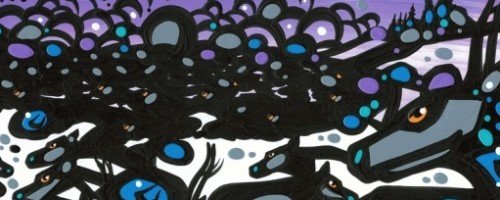
Caribou Song
The dual language Caribou Song by award-winning author and playwright Tomson Highway was first published in 2001 with illustrations by Brian Deines. The story is in print again, with stunning new illustrations by John Rombough, a Chipewyan Dene artist living in the Northwest Territories. Also new is the inclusion of a colloquial (Ateek Oonagamoon) dialect of Cree, replacing the original high Cree (Atihko Nikamon) translation.
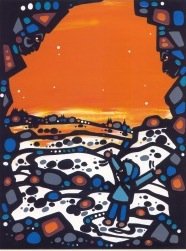 Set in Manitoba ‘too far north for most trees’, Caribou Song is the story of two brothers, Joe and Cody, who follow the year-long caribou migration with their parents. They live a traditional, nomadic life of dog sleds, bannock, and rather unexpectedly, accordion music. To engage the caribou and draw them out of the forest into the open, Joe plays the accordion, called kitoochigan in Cree, while his brother Cody dances ‘with his arms up like antlers.’ Music, as they say, soothes the savage ungulate.
Set in Manitoba ‘too far north for most trees’, Caribou Song is the story of two brothers, Joe and Cody, who follow the year-long caribou migration with their parents. They live a traditional, nomadic life of dog sleds, bannock, and rather unexpectedly, accordion music. To engage the caribou and draw them out of the forest into the open, Joe plays the accordion, called kitoochigan in Cree, while his brother Cody dances ‘with his arms up like antlers.’ Music, as they say, soothes the savage ungulate.
One day in late spring, the caribou heed the boys’ musical call in an exhilarating and dangerous way. ‘Faster than lightening’, ten thousand caribou fill the meadow. As a sea of antlers roars by, Cody takes Joe by the hand and ‘swims’ to a big rock, where they hear the spirit voice of the caribou rising above the din of the herd. The boys lift their arms in exultation, embracing the spirit. Fearing the worst, the parents are relieved to see Joe and Cody laughing on the rock as the herd dissipates.

Here Be Monsters
The title of Jonathan Emmett and Poly Bernatene’s new book Here Be Monsters is a play on Here Be Dragons, an admonishment printed in the corners of medieval maps to prevent seafaring types from wandering into uncharted territory. Ascribing evil to the unknown is common enough even today, but back then, it seemed reasonable to personify fear as a fire-breathing dragon. We now know these fears were unfounded. There are no dragons, no monsters. Good news if you’re a pirate, and an island of giant gemstones lay concealed in the murky mist of a faraway, uncharted land. Here be monsters, indeed.
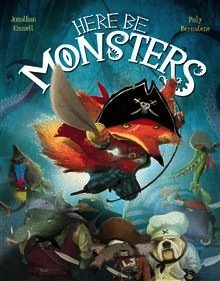 Captain Cut-Throat is the ‘meanest mariner to sail the Seven Seas’, guilty of ‘countless crimes of downright dastardliness and despicable dishonesty’, or so the Wanted Dead or Alive poster tells us. The peg-legged, pointy-nosed fox leads a crew of equally unsavoury characters, all of whom are wanted for various crimes, including ‘mean misconduct and monstrous mischief’ (Blue-Bottomed Bart, a mandrill), and ‘reprehensible rudeness and repulsive roguery’ (Quilly Von Squint, a raven), among other alliterative (and hilarious) misdeeds. As befitting a pirate of the highest order, Captain Cut-Throat likes treasure. Loves it in fact, refusing to heed his crew’s misgivings as he sets sail for the mysterious island of gems. Calm seas prevail until the ship enters the mist, where strange noises can be heard. One after the other, the crew plead with the captain, only to be plucked off the ship in spectacular fashion by, in turn, a giant, teeth-baring parrot and a multi-eyed serpent. Thinking his ‘yellow-bellied’ crew have abandoned ship, the captain remains steadfast in his goal, oblivious to what actually transpired on his ship. The bejeweled island emerges out of the mist, and Captain Cut-Throat greedily sets paw and peg on land to claim his reward. And he gets it. Boy, does he get it. These gems don’t just sparkle, they bite.
Captain Cut-Throat is the ‘meanest mariner to sail the Seven Seas’, guilty of ‘countless crimes of downright dastardliness and despicable dishonesty’, or so the Wanted Dead or Alive poster tells us. The peg-legged, pointy-nosed fox leads a crew of equally unsavoury characters, all of whom are wanted for various crimes, including ‘mean misconduct and monstrous mischief’ (Blue-Bottomed Bart, a mandrill), and ‘reprehensible rudeness and repulsive roguery’ (Quilly Von Squint, a raven), among other alliterative (and hilarious) misdeeds. As befitting a pirate of the highest order, Captain Cut-Throat likes treasure. Loves it in fact, refusing to heed his crew’s misgivings as he sets sail for the mysterious island of gems. Calm seas prevail until the ship enters the mist, where strange noises can be heard. One after the other, the crew plead with the captain, only to be plucked off the ship in spectacular fashion by, in turn, a giant, teeth-baring parrot and a multi-eyed serpent. Thinking his ‘yellow-bellied’ crew have abandoned ship, the captain remains steadfast in his goal, oblivious to what actually transpired on his ship. The bejeweled island emerges out of the mist, and Captain Cut-Throat greedily sets paw and peg on land to claim his reward. And he gets it. Boy, does he get it. These gems don’t just sparkle, they bite.

Young Frank Architect
“Youth is a quality, not a matter of circumstances.” Frank Lloyd Wright
So begins Frank Viva’s new book, Young Frank Architect, and this reassuring adage plays out in the inspiring story of passion and artistic vision as embodied by a young boy, his grandfather, and a host of famous architects and designers. Young Frank Architect is also an homage to the Museum of Modern Art in New York City, a place I have not yet visited but whose breadth of genius has long been a draw. With the publication of Young Frank Architect, a trip to MoMA is in order, and though contained within the pages of a picture book, the famous museum is no less an adventure.
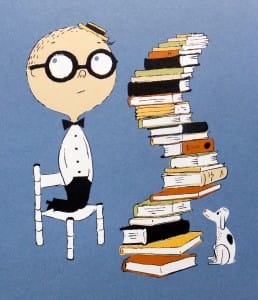 Young Frank is a creative soul with a very broad idea of what it means to be an architect. Old Frank, his grandfather, is an actual architect whose views have, perhaps, narrowed over the years. The boy aspires to be like his grandfather in more ways than one, even adopting his straw hat and comically round glasses. The grandfather watches his grandson build twisty skyscrapers out of piles of books and a chair of toilet paper rolls, and attempts to educate the boy on the rules of his profession. “I don’t think architects make chairs. And you really can’t sit in this one, can you?” says Frank, which of course, deflates the young boy’s exuberance. Bewildered by his grandson’s unorthodox architectural creations, Old Frank takes the boy to the Museum of Modern Art “…to see the work of some REAL architects.’
Young Frank is a creative soul with a very broad idea of what it means to be an architect. Old Frank, his grandfather, is an actual architect whose views have, perhaps, narrowed over the years. The boy aspires to be like his grandfather in more ways than one, even adopting his straw hat and comically round glasses. The grandfather watches his grandson build twisty skyscrapers out of piles of books and a chair of toilet paper rolls, and attempts to educate the boy on the rules of his profession. “I don’t think architects make chairs. And you really can’t sit in this one, can you?” says Frank, which of course, deflates the young boy’s exuberance. Bewildered by his grandson’s unorthodox architectural creations, Old Frank takes the boy to the Museum of Modern Art “…to see the work of some REAL architects.’

Ghosts
October has arrived, wind-swept and leaf-strewn; a seasonal reminder that it’s time to bone up on my ghosts. Like the would-be spectre dragging a ball and chain in Sonia Goldie and illustrator Marc Boutavant’s newly translated book Ghosts, I am poorly educated in the ectoplasmic sciences. No matter, with the help of this extraordinary (and extrasensory) book, I can now distinguish between the winter-loving ghost who lurks behind curtains drawing pictures on frosted window panes, the soot-covered Chimney Ghost, and of course, the oft-maligned Night Ghost. I’ve much to learn, and many preconceptions that barely scratch the surface of this delightful and diverse society of apparitions.
 Originally published in 2001 in France, Ghosts is a whimsical introduction to the domestic variety of ghost populating the bedrooms and kitchens of our homes in (apparently) great multitude and variety. Leading the tour is a tiny bear-like ghost named Toasty, and his protege, an old-fashioned fellow from the ‘sheet’ and ‘boo’ era who may or may not be a real ghost. Wishing to dispel the myth that ghosts live only in old castles and haunted houses, Toasty invites his new friend to a party for all the household ghosts, who are introduced one by one. Turns out, we corporeal types are far from alone, and as I’d always suspected, not solely responsible for the mess and mayhem in our homes. There are mischief-makers in our midst.
Originally published in 2001 in France, Ghosts is a whimsical introduction to the domestic variety of ghost populating the bedrooms and kitchens of our homes in (apparently) great multitude and variety. Leading the tour is a tiny bear-like ghost named Toasty, and his protege, an old-fashioned fellow from the ‘sheet’ and ‘boo’ era who may or may not be a real ghost. Wishing to dispel the myth that ghosts live only in old castles and haunted houses, Toasty invites his new friend to a party for all the household ghosts, who are introduced one by one. Turns out, we corporeal types are far from alone, and as I’d always suspected, not solely responsible for the mess and mayhem in our homes. There are mischief-makers in our midst.

Tiger Goes Tiger
The most rewarding, and the most difficult journey in life is to become who we are. For a lucky few, it’s no journey at all, for others, it takes years if not decades to shed the layers that mask our true selves. There are many pressures to conform, to fit in, and we adapt our personalities in ways which can often feel fraudulent. In Mr. Tiger Goes Wild, Peter Brown masks his protagonist in a waistcoat and top hat. He also makes him a tiger; a very proper, and very bored tiger.
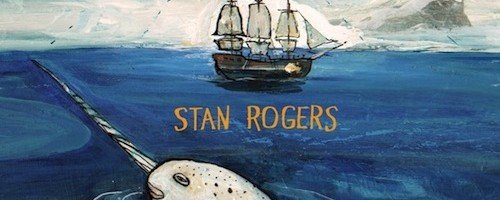
A Land So Wide and Savage
On a hill more than thirty years ago, I first heard the unmistakeable voice of Stan Rogers. It was the Edmonton Folk Music Festival in 1982. As the hot August sun beat down my haltered back, the bearded balladeer’s muscular baritone percussed through the grounds like a drumbeat, tossing flimsy-voiced folksingers in its wake, demanding that we pay attention to the stories of our country, that we be upstanding for the narrative of Canada. And so I stood.
 Canadians love to talk about what it means to be Canadian. That we have yet to reach a consensus is proof that we are a diverse people. Diverse, and indecisive. Still, there is common ground: a national predilection for caffeinated beverages in the name of a deceased hockey player, doughnuts from said deceased hockey player, hockey, snow, and, for a lot of us, the music of Stan Rogers.
Canadians love to talk about what it means to be Canadian. That we have yet to reach a consensus is proof that we are a diverse people. Diverse, and indecisive. Still, there is common ground: a national predilection for caffeinated beverages in the name of a deceased hockey player, doughnuts from said deceased hockey player, hockey, snow, and, for a lot of us, the music of Stan Rogers.
I knew him through my music-loving sister, who wept the day he died in 1983 at the age of 33. “Who will sing about us?”, she said. Indeed. Folksingers abound, but few tell stories that enrich a nation’s perception of itself, and even fewer take on the lead-lined pages of a failed northern expedition and turn it into a song that endures. Northwest Passage by Governor General award nominee Matt James is not only a celebration of the Stan Roger’s most famous song, it is also a glimpse into an historical event that still resonates into the 21st century.

Once Upon a Northern Night
On rare occasions, a picture book comes my way that is so evocative, it feels like a lost memory from childhood, revealing itself page after page. Once Upon a Northern Night is a such a book. Oddly out of time, and yet timeless, Once Upon a Northern Night is a breathsucker, a gust of cold winter air awakening the senses. After several readings, I am still amazed that this glorious book has been in existence for a mere few months, not fifty years. The gentle poetry of Jean Pendziwol has the lilt and reverence of an old bedtime story, the kind without irony or guile. Like Pendziwol’s words, Isabelle Arsenault’s luminous illustrations belong to a bygone era of limited palettes and charmingly stylized imagery. If books have souls, then Once Upon a Northern Night is an old soul.


